![]()
![]()
![]()
Use LEFT and RIGHT arrow keys to navigate between flashcards;
Use UP and DOWN arrow keys to flip the card;
H to show hint;
A reads text to speech;
30 Cards in this Set
- Front
- Back
|
Cellular respiration |
Process in which cells consume O and produce CO2 Provides more E (ATP) from glucose than glycolysis |
|
|
3 major stages |
Acetyl CoA production Acetyl CoA oxidation e- transfer and oxidative phosphorylation |
|
|
Respiration stage 1: Acetyl-CoA production |
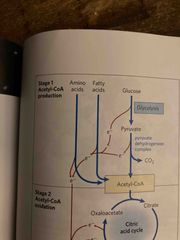
Generates some ATP, NADH, FADH2 Carbs release 1/3 of total potential CO2 during stage 1 |
|
|
Respiration stage 2: Acetyl-CoA oxidation |
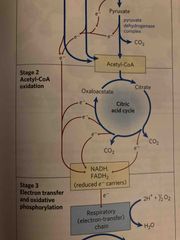
Generates more NADH FADH2 and one GTP Remaining C atoms from carbohydrates, amino acids, and fatty acids are released during this stage |
|
|
Respiration stage 3: oxidative phosphorylation |
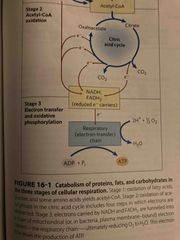
Generates the vast majority of ATP during catabolism |
|
|
In eukaryotes stages 2 & 3 are localized to mitochondria |

Glycolysis occurs in cytoplasm Citric acid cycle occurs in mitochondrial matrix Oxidative phosphorylation occurs in the inner membrane |
|
|
Conversion of pyruvate to Acetyl CoA |

Catalyze by the pyruvate dehydrogenase complex Requires 5 coenzymes TPP, lipoate, FAD, NAD+, CoA-SH |
|
|
Structure of lipoate |
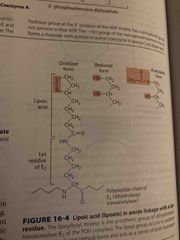
Prosthetic groups are strongly bound to the protein Lipoic acid is covalently linked to the enzyme via a lysine residue |
|
|
Pyruvate dehydrogenase complex (PDC) |

A large multienzyme complex includes: Pyruvate dehydrogenase, dihydrolipoyl transacetylase, dihydrolipoyl dehydrogenase |
|
|
Advantages of multienzyme complexes |
The short distance btw catalytic sites allows channeling of substrates from one catalytic site to another Channeling minimizes side rxn Regulation of activity of one subunit affects the entire complex |
|
|
Sequence of events in oxidative decarboxylation of pyruvate |

Enzyme 1: Step1-decarboxylation of pyruvate to an aldehyde Step 2- oxidation of aldehyde to a carboxylic acid Enzyme 2: Step 3- formation of Acetyl-CoA (product 1) Enzyme 4- Step4- reoxidation of the lipoamide cofactor Step 5- regeneration of oxidized FAD cofactor (forming NADH product 2) |
|
|
Citric acid cycle |
8 steps summarized 1. Make citrate 2. Isomerization 3-4. Produce 2 NADH 5. GTP which converts to ATP 6. FADH2 7. Hydration 8. NADH |
|
|
Step 1 citrate synthesis |
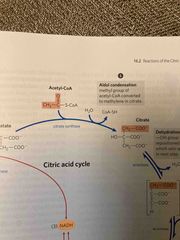
Condensation of Acetyl CoA and oxaloacetate The only rxn with a C-C bond formation An acid/base catalysis Rate limiting step and activity largely depends on oxaloacetate Highly favorable/irreversible Regulated by substrate availability and product inhibition |
|
|
Induced for in citrate synthase |
Conformational change after binding of oxaloacetate allows CoA to bind |
|
|
Step 2:aconitase isomerization by dehydration/rehydration |

Elimination of H2O from citrate gives a cis C=C bond (lyase) Citrate (3 degree OH) is poor for oxidation so rearrange to get Ioscitrate (2 degree OH) is good substrate for oxidation |
|
|
Aconitase |
Contains iron sulfur center Stereospecific |
|
|
Step 3: isocitrate dehydrogenase-oxidative decarboxylation |

Specific for NADP (cytosolic) or NAD+ (mitochondria) 1. Isotrate is oxidized to NADH or NADPH 2. Decarboxylation is facilitated by e- withdrawal (carbonyl and Mn). Releases CO2! 3. Rearrangement of the enol intermediate creates alpha-ketoglutarate Highly favorable/irreversible and regulated by ATP |
|
|
Step 4: alpha-ketoglutarate dehydrogenase: final oxidative decarboxylation |

Last oxidative decarboxylation Succhinyl CoA is another high thioester bond Highly favorable/irreversible |
|
|
Alpha-ketoglutarate dehydrogenase |

Complex similar to pyruvate dehydrogenase Same coenzymes, identical mechanisms Active sites differ to accommodate different-size substrates |
|
|
Step 5: succinyl CoA synthestase |

Substrate level phosphorylation Goes through a phospho-enzyme intermediate Produced GTP (converts to ATP) Slightly favorable and reversible |
|
|
Step 6: succinate dehydrogenase: oxidation of all and to alkene |

Bound to mitochondrial inner membrane Reduction of the alkane to alkene requires FADH2 ( too low for NADH) Near equilibrium/ reversible |
|
|
Step 7: fumurase hydration across a dble bond |

Water addition is always trans and forms L-Malate OH- adds to fumerate then H+ adds to carbanion Either C can gain OH- |
|
|
Step 8: malate dehydrogenase:oxidation of OH tons ketone and regeneration of oxaloacetate |
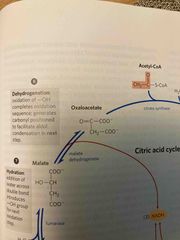
Final step Regenerates oxaloacetate for citrate synthase Highly unfavorable/ reversible |
|
|
Summary of citric acid cycle |

Back (Definition) |
|
|
Net results |
Added: 2 C from Acetyl CoA, 3 NAD+, FAD, GDP, Pi, 2 H2O Got: 2 CO2, 3 NADH, FADH2, GTP, CoA, 3H+ |
|
|
Total ATP made from glycolysis and the citric acid cycle |
30-32 |
|
|
Anaplerotic rxn |
Intermediates in CAC can be used in biosynthetic pathways (removed from cycle) Most important is pyruvate carboxylase reversed to form oxaloacetate |
|
|
Biotin (pyruvate carboxylase) |
CO2 carrier so important |
|
|
Regulation of CAC |

Regulated at highly favorable/ irreversible steps by: Activated substrate availability Inhibition by product accumulation Overall products of the pathway are NADH and ATP which can inhibit or activate if high levels of NAD+ and AMP
|
|
|
Also regulation is pyruvate dehydrogenase |
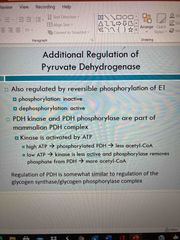
See pic |

